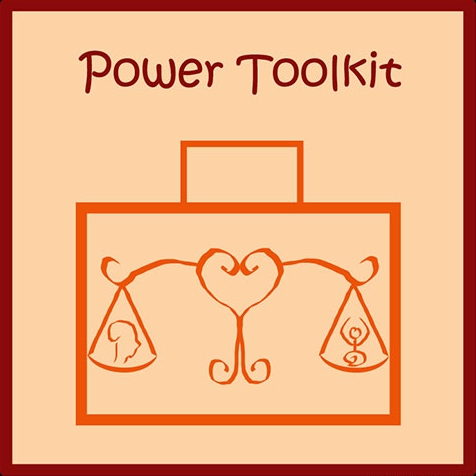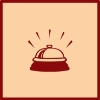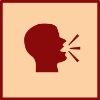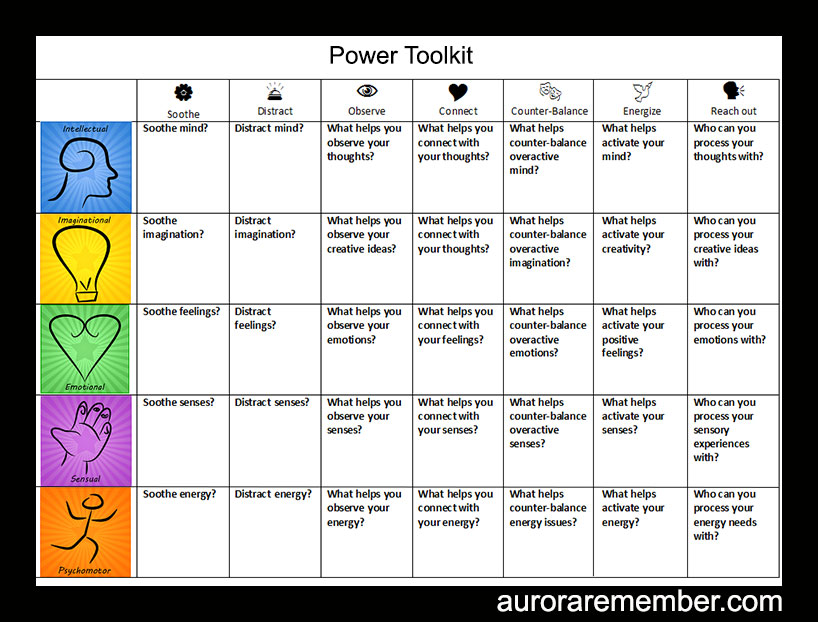
Mastering others is strength. Mastering yourself is true power. ~ Lao Tzu
I’ve spoken a lot these past few weeks about how our intensity can be our greatest asset. You might be thinking, “well that’s great and all, but how do I use that intensity if I’m too overwhelmed by my thoughts and feelings to even know where to begin?”
One of the strategies I use in my Ignite Your Power! program is to develop a Power toolkit of things that help you feel back in control. This involves putting together physical items that help you refocus your energy along with reminders and possibly phone apps such as guided meditations and white noise. On the table below, I include seven types of tools that you might consider, along with some examples of the types of things you might use for each excitability.

Soothe
This is the category that is probably talked about most often. To effectively think about your next move, you must come from a place of calm – or at least not be revved up enough so that the reasoning part of your brain shuts down.
Ask yourself, What helps soothe my mind, imagination, feelings, senses and restless energy?
Possible items might include: Inspirational writing, quotes, guided imagery, grounding objects (rock, paperweight), acupressure points, tapping/EFT (Emotional Freedom Technique); sensory soothers such as: Touch (soft, squishy). See (movement, peaceful) Hear (music, guided meditation, white noise). Taste (mints, tea). Smell (candles, oils); as well as physical soothers such as yoga, stretches, walks and calming movement.

Distract
Sometimes when our mind is going a mile a minute without stopping, we need to distract ourselves to disengage from our thoughts. The purpose of distracting yourself is to break yourself of the pattern and move on. Use these tools sparingly as you don’t want to get stuck on the chosen distraction. Consider setting a timer or reminder of when to end the distraction and move on to something else.
Ask yourself, What helps distract my mind, imagination, feelings, senses and restless energy?
Possible items might include: puzzles, books, crossword puzzles, sudoku, artwork, crafts, crochet, sewing, positive websites, movies, music, movement, walking, dancing and exercise.

Observe
Once we are calm and out of self defeating thought loops, we can get the space to observe our situation.
Ask yourself: What helps me make objective observations? How do I step back from my emotions or thoughts to see clearly?
Possible items might include: Mindfulness tools, timer, journaling, progressive muscle relaxation and walking meditation.

Connect
Soothing and distracting yourself may temporarily disconnect you with your feelings, but it is important not to ignore them. When you can make clear objective observations, you can start to connect with your underlying feelings and needs about the situation.
Ask yourself: How do I connect with my thoughts, ideas, feelings, senses and/or energy?
Possible items might include: Journal, drawing, art supplies, list of feelings & needs, yoga and breathing exercises.

Counter-balance
If you are prone to a repetitive pattern of feelings or thoughts, it can be useful to have tools that counter-balance those feelings or thoughts. For example, if you are constantly self-critical, it could be helpful to write down affirmations to read to yourself.
Ask yourself: What helps counter-balance overactive mind, imagination, emotions, senses and energy issues?
Possible items might include: Mindless activities (use sparingly as with distracting items), grounding activities, affirmations, inspirational messages, funny or cheering writings or videos, pleasant sensations and calming or energizing activities.

Energize
While it is important to find soothing activities, it is equally important to find activities that boost your energy and inspiration.
Ask yourself: What helps activate my mind, creativity, positive feelings, senses and energy?
Possible items might include: Inspirational readings, ideas and messages, dream boards, things to touch, see, hear (music), taste (tea), smell (oils), energizing movement and dancing.

Reach out
Finally, it is helpful to remember that you are not doing this alone. Make a list of people who you can count on to help.
Ask yourself: Who can I process my thoughts, creative ideas, emotions, sensory experiences and/or energy needs with?
Possible people might include: Friends, family, mentors, teachers, counselors and coaches.
Now it’s your turn, what tools do you use to reconnect with your own power?
If you’d like to explore this further, there’s still time to join us in my Ignite Your Power! program,

